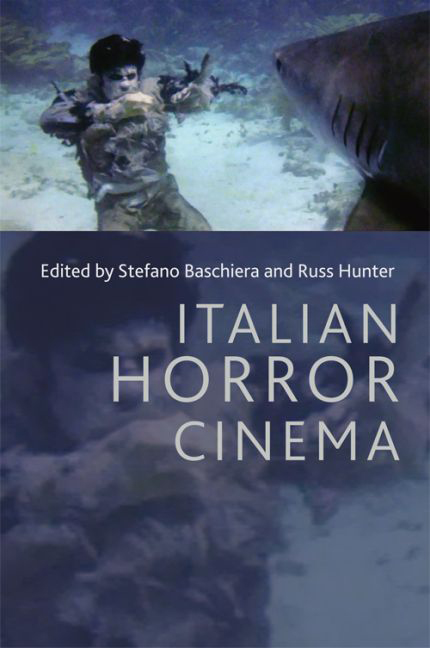Book contents
- Frontmatter
- Contents
- List of figures
- List of contributors
- Acknowledgements
- Introduction
- 1 Preferisco l'inferno: early Italian horror cinema
- 2 Domestic films made for export: modes of production of the 1960s Italian horror film
- 3 The 1980s Italian horror cinema of imitation: the good, the ugly and the sequel
- 4 Knowing the unknown beyond: ‘Italianate’ and ‘Italian’ horror cinema in the twenty-first century
- 5 Bavaesque: the making of Mario Bava as Italian horror auteur
- 6 The Argento Syndrome: aesthetics of horror
- 7 Scrap metal, stains, clogged drains: Argento's refuse and its refusals
- 8 The giallo /slasher landscape: Ecologia del delitto, Friday the 13th and subtractive spectatorship
- 9 Kings of terror, geniuses of crime: giallo cinema and fumetti neri
- 10 Political memory in the Italian hinterland: locating the ‘rural giallo’
- 11 The horror of progressive rock: Goblin and horror soundtracks
- 12 ‘The only monsters here are the filmmakers’: animal cruelty and death in Italian cannibal films
- 13 Italian horror cinema and Italian film journals of the 1970s
- Index
7 - Scrap metal, stains, clogged drains: Argento's refuse and its refusals
Published online by Cambridge University Press: 12 September 2017
- Frontmatter
- Contents
- List of figures
- List of contributors
- Acknowledgements
- Introduction
- 1 Preferisco l'inferno: early Italian horror cinema
- 2 Domestic films made for export: modes of production of the 1960s Italian horror film
- 3 The 1980s Italian horror cinema of imitation: the good, the ugly and the sequel
- 4 Knowing the unknown beyond: ‘Italianate’ and ‘Italian’ horror cinema in the twenty-first century
- 5 Bavaesque: the making of Mario Bava as Italian horror auteur
- 6 The Argento Syndrome: aesthetics of horror
- 7 Scrap metal, stains, clogged drains: Argento's refuse and its refusals
- 8 The giallo /slasher landscape: Ecologia del delitto, Friday the 13th and subtractive spectatorship
- 9 Kings of terror, geniuses of crime: giallo cinema and fumetti neri
- 10 Political memory in the Italian hinterland: locating the ‘rural giallo’
- 11 The horror of progressive rock: Goblin and horror soundtracks
- 12 ‘The only monsters here are the filmmakers’: animal cruelty and death in Italian cannibal films
- 13 Italian horror cinema and Italian film journals of the 1970s
- Index
Summary
It is a cliché to title a critical account of horror with a list of things. Things such as those that precede the colon in my title announce the uncanny role given to them and the expressive hyperbole granted objects by horror diegesis. What I find interesting about this titular evocation of horror's things is that the books and essays they announce rarely address these objects themselves. Instead, horror's things are pretexts for a discussion of the unique affective registers of horror or its exuberant corporeality. This essay will attempt to account for things in the giallo and horror films made by Dario Argento during the first decade of his directorial career, widely regarded as his canonical period. In what follows, I largely bracket the infamously wasted bodies of those iconic films in order to allow the matter that populates Argento's miseen- scène to come to the fore. I argue that this imagery in Argento is ecological, if by ecology we mean the study of the interplay of organisms, things and the world, or – as the Garzanti dictionary puts it – ‘science that studies the relations between living beings and the surroundings in which they live’.
Is there not something ecological in Argento's camera lingering on still spaces marked by the presence of their former occupant? Objects describe the past life of these places, like the ground level close-up of a cigarette butt in an abandoned city square in Argento's 1971 slasher thriller Quattro mosche di velluto grigio/Four Flies on Grey Velvet. Or the limp streamers and confetti in a theatre trashed by a party that has just ended in the same film. The camera discovers this latter detritus only moments before fixing on a dead body strewn among it. So then a sense of the ecological emerges not just in the actual image of waste but also in its treatment, in the camera's refusal to treat it as refuse. This ecological awareness is signalled in the discussion of polluted waters in the film's scene at the fishing shack, and moreover in the seemingly odd prominence given to the shack's patchy walls, which come to dominate the frame for a few seconds and which are later echoed in the grime-stained city wall.
- Type
- Chapter
- Information
- Italian Horror Cinema , pp. 111 - 126Publisher: Edinburgh University PressPrint publication year: 2016



